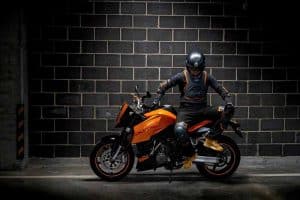Motorcycling in the U.S. is alive and well, with at least 8.02% of households owning at the minimum one motorcycle. Yet, it’s important to acknowledge the inherent risks involved, as most of us still fear crashing and being injured, or worse. The gravity of motorcycle accidents tends to be far more serious than typical car accidents, with motorcyclists being 27 times more likely to die in an accident than car occupants.
It’s a heartbreaking statistic, but it doesn’t mean that you should ditch your bike out of fear. The truth is, you can enjoy the freedom, adventure, and individuality that motorcycle riding offers without worrying as much about your safety. Arguably, the best way to do so is to invest in the right motorcycle safety gear.
Well, in this post, I’ve prepared a comprehensive guide to motorcycle body armor to help you protect yourself during crashes both on and off the racetrack. Ready for some quick recommendations?
| Armor Name | Category | Safety Certification | Check & Shop Now |
|---|---|---|---|
| Icon Field Armor 3 | Best Armored Vest | EN 1621-3 2018 Class C | RevZilla | CycleGear | MotoSport |
| Alpinestars Bionic Tech V2 | Best Armored Jacket | EN 1621-3:2018 Level 2 | RevZilla | CycleGear | Amazon |
| Klim Outlander GTX | Best Armored Boots | 5mm/3mm Perforated Foam | RevZilla | CycleGear | J&P Cycles |
| Surlim SR Elbow Knee Protector CE Armor Inserts | Best Knee and Elbow Armor | EN1621-1:2012 Level 1 | Amazon |
| Alpinestars Missile V2 Airflow | Best Armored Suit | prEN 17092 Class AAA | RevZilla | CycleGear | Amazon |
| REV'IT! Seesoft Back Protector Insert | Best Back Protector | prEN 1621-2:2010 Level 2 | RevZilla | J&P Cycles | CycleGear |
| BARHAR Protective Armor | Best Hip Armor | EN 1621-1:2012 Level 1 | Amazon |
| Alpinestars Flex Pro | Best Shoulder Protector | EN 1621-1:2012 Level 2 | RevZilla | CycleGear | Amazon |
What Is Motorcycle Body Armor?
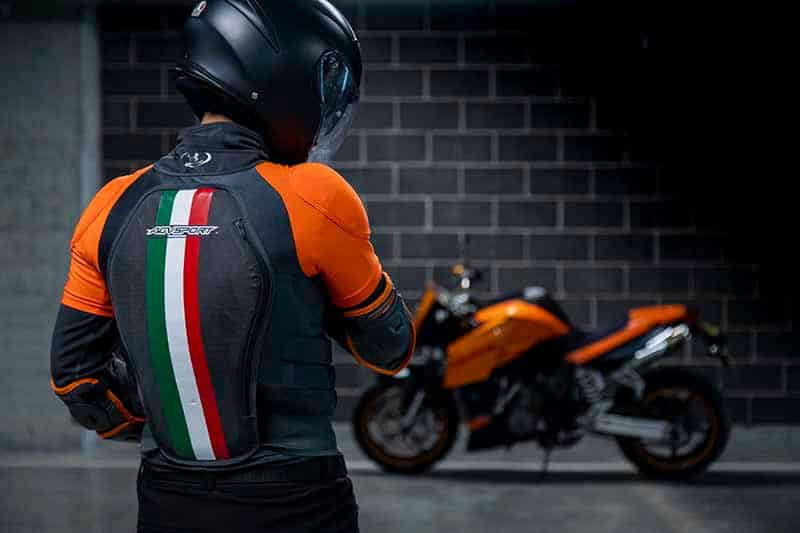
Motorcycle body armor is simply protective equipment made from a combination of hard thermoplastic resins for the outer shell and resilient foam liners to absorb the energy and shock from the impact of a crash. The foam linings are made from high-tech compounds that are capable of absorbing large amounts of energy in case of an impact and then rebound for a second or even third impact.
Basically, there are two main types of motorcycle body armor:
- Replacement Armor: These are armor paddings that go into armor pockets on jackets, shorts, and pants among other motorcycle clothing. Replacement armor pads are designed to improve your gear’s original armor pads.
- Strap-On Armor: These are body armor pads that are worn on your body. Frequently used in off-road riding and track racing such as motocross.

Why Do You Need Body Armor When Riding A Motorcycle?
Wearing body armor while riding a motorcycle is essential for any rider’s safety, as it provides needed protection in the event of accidents or crashes. For instance, if a rider is thrown from the motorcycle or collides with another object, the body armor will reduce the risk of serious injuries to vital body parts as is made of materials that can absorb and distribute the force of impact. It also helps reduce friction if a rider slides on the road during a crash, which prevents severe abrasions or “road rash.”
Moreover, many countries have safety standards and regulations that legally require riders to wear specific protective gear, including helmets and sometimes body armor. Riders need to adhere to these standards to avoid fines or other penalties.
Does Motorcycle Body Armor Work?
Yes, motorcycle body armor works exceptionally well and can prevent serious bodily injuries, including broken bones. The right type of high-quality and well-fitting armor can protect you against impacts in the event of an accident, significantly reducing body damage by an impressive 76 percent.
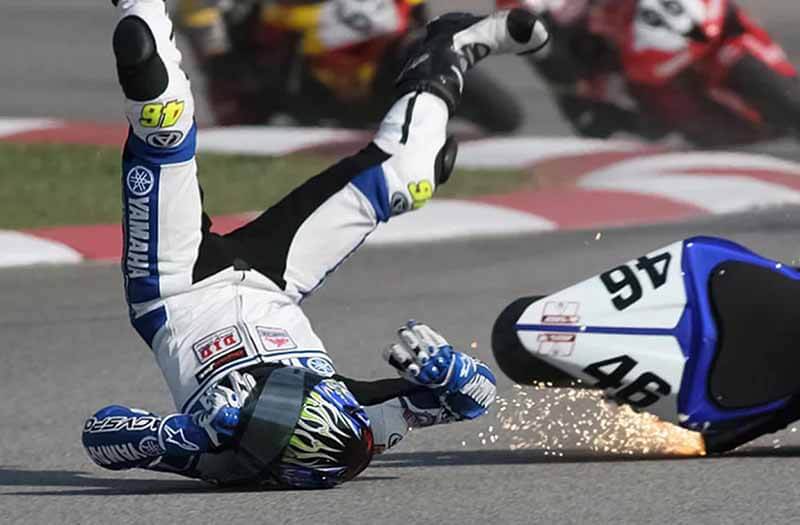
Some motorcycle armor will also yield substantial protection against abrasion, but the goal with the protective gear is to absorb and dissipate any impact force directed at you so that the least amount of force is transferred to your body. The higher the ability of motorcycle armor to reduce the transmitted force of an impact, the more protective it is.
How Do I Wear Motorcycle Body Armor?
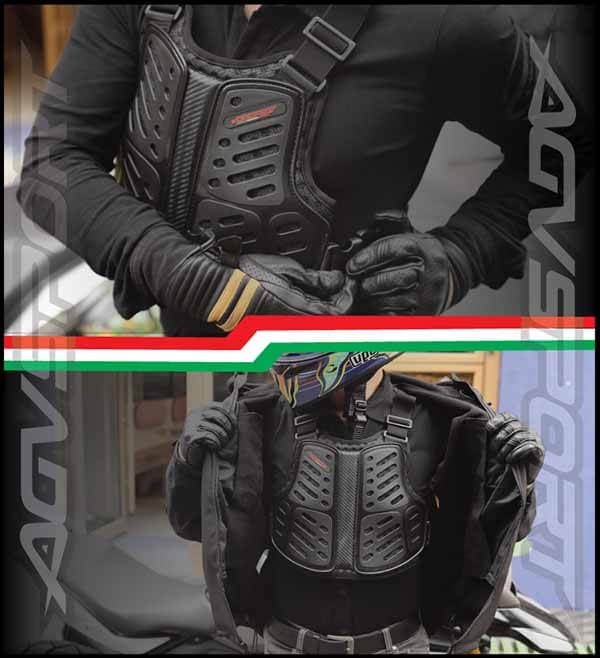
How you wear motorcycle armor mainly depends on the type you choose. As it goes, you can protect the different areas of your body by inserting armor pads in your motorcycling apparel, by directly strapping armor pads, or by wearing armored base layers or armored gear.
One of the key factors in achieving maximum protection is to make sure the armor fits snuggly so that it does not twist and move in the event of a crash.
For the base layers and armored motorcycle gear, they simply go inside your jacket, pants, or suit. All you need to do is find the right size and wear it under your normal riding gear, providing protection for the desired body parts.
How to Choose the Right Motorcycle Body Armor?
Choosing the right motorcycle body armor is crucial for ensuring maximum protection and comfort while riding a motorcycle. Here are some factors to consider when making this decision:
- CE Certification: Look for body armor that has received certification from the Conformité Européene (CE). This certification ensures that the armor meets specific safety standards.
- Material and Construction: Examine the materials used in the construction of the body armor. High-quality armor often incorporates materials like Kevlar, leather, and reinforced textiles for optimal protection. The construction should be sturdy with strong stitching to ensure durability.
- Impact Protection: Check for armor that provides adequate impact protection for key areas such as the back, shoulders, elbows, chest, and knees. Some gear may come with removable or adjustable protectors to customize the level of protection based on your preferences and riding conditions.
- Fit and Comfort: Proper fit is crucial for both safety and comfort. Ensure that the body armor fits snugly without being too tight or restrictive. Many manufacturers offer different sizes and adjustable straps for a customized fit.
- Ease of Use: Choose armor that is easy to put on and take off. Features like zippers, adjustable straps, and quick-release mechanisms can enhance convenience, especially if you frequently take off and put on your gear.
- Ventilation: Adequate ventilation is important, especially if you ride in warmer climates. Look for armor with perforations, mesh panels, or other ventilation features to enhance airflow and keep you cool.
- Layering Compatibility: Consider how the body armor integrates with the rest of your riding gear. Some gear is designed to accommodate additional layers for insulation in colder weather.
- Budget: While safety is paramount, consider your budget. Quality body armor doesn’t always come cheap, but it is a worthwhile investment in your safety. Look for a balance between cost and the level of protection and features you need.
By carefully considering these factors, you can choose body armor that aligns with your riding style, safety requirements, and budget.
CE Standard – Ever Wondered What the CE on Motorcycle Body Armor Means?
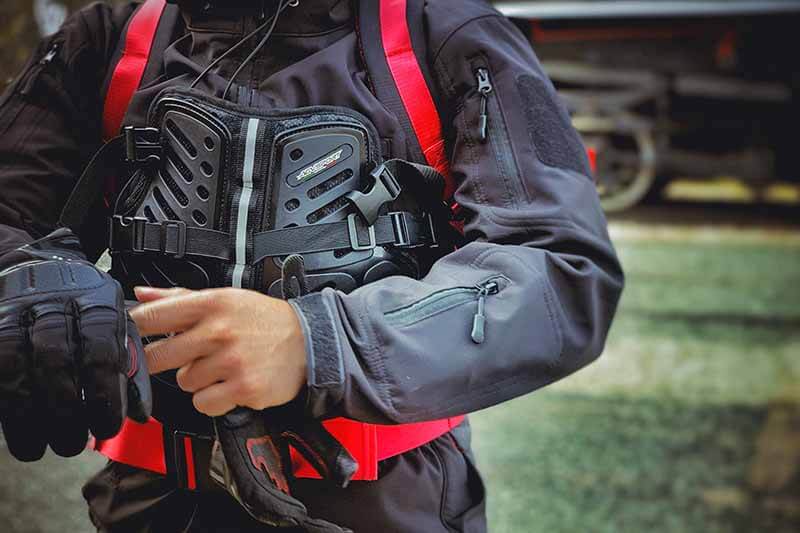
Well, it is a rating standard developed by European Union researchers and scientists, but any manufacturer from any country can certify its motorcycle armor under any corresponding CE standard.
You’ll notice that almost all of the motorcycle armor categories listed below are CE-certified. That is mainly because of the ability of such standards to objectively test the impact protection of the motorcycle armor.
Each CE standard specifies the maximum amount of transmitting force that can be employed during testing. Therefore, if a tested armored object satisfies the CE standard’s testing process, it can be certified as “protective.”
What Is the Difference: CE Level 1 vs. CE Level 2?
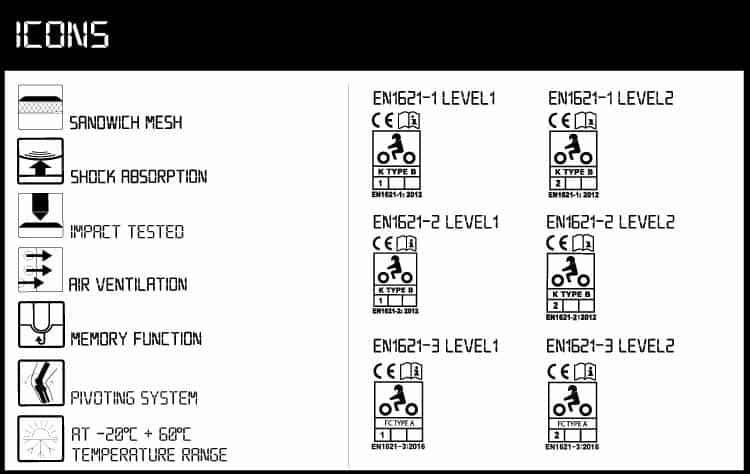
The fact is, many people are confused by this topic, which is why we’re going to clarify things right now.
Any tested and approved motorcycle armor will be certified as to whether it meets Level 1 or Level 2 CE standards. An independent test laboratory will issue this certification for each different model of motorcycle armor (provided that the armor has passed the test). In comparison to a Level-2 certification, a Level-1 certification provides less impact protection.
How Do You Read Motorcycle Armor?
If you want to find out the armor’s certified level, check around the supplied pad for a pictogram of a motorcycle with a “1” or “2” next to the initials. The number represents the armor’s approved CE Level (as Level 1 or Level 2). Note that the motorcyclist pictogram may not be present on older motorcycle armor.
Besides, it is also imperative to check the different codes. The rating number of certain armor is indicated by certain codes. For instance, in a code like EN1621-2:2021, every line has its own story to tell. The numbers following EN indicate the level of protection given. In this case, 1621 denotes that the armor is suitable for use on a motorcycle.
The area of defense will be revealed next by -2. The -1 code denotes that the shield can be worn everywhere on the body except the rear. The -2 code is also meant to show that the shield is intended for use on the rear.
Technically, as you might have guessed, Level 2 body armor is better than Level 1. They can absorb a transmission force of up to 12 Kn.
What Are Different Categories of Motorcycle Body Armor?
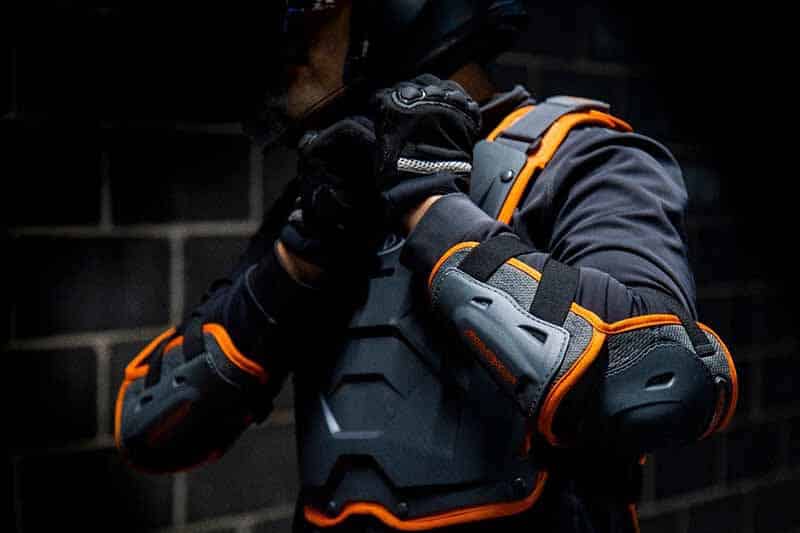
After learning about the two types of protective wear available to motorcycle riders (replacement and strap-on) as well as the CE rating criteria, here are the seven categories of motorcycle armor you should familiarize yourself with:
- Knee Armor: Provides knee and shin protection. The EN 1621-1 CE standard classifies this item as “limb armor.”
- Back Armor: It fully or partially shields the back. The EN 1621-2 CE standard was used to certify this product.
- Elbow Armor: This armor ensures that elbows and forearms are well-protected. The EN 1621-1 CE standard classifies this item as “limb armor.”
- Shoulder Armor: This armor ensures that the entire shoulder girdle is protected. The EN 1621-1 CE standard classifies this item as “limb armor.”
- Chest Armor: It ensures that the thorax and rib cage are protected. The EN 1621-3 CE standard was used to certify this product. If utilized as off-road chest shields, the EN 14021 CE standard must be followed.
- Hip Armor: It ensures the hips are well-protected. The EN 1621-1 CE standard classifies this item as “limb armor.
- Armored Base Layers: Body armored, elasticated clothing. You can make yourself more secure with the use of armored underlayers. They have elastic shells or snug-fitting frames to keep all armored pads securely in place. Technically, you can wear these garments under any clothes.
What About Armored Motorcycle Gear?
Next, I will look at different motorcycle protective wear that comes with body armor. Thanks to the technology integrated into their safety design, there are also jackets, vets, shirts, pants, shorts, and yes, even suits that have body armor.
1. Armored Vests
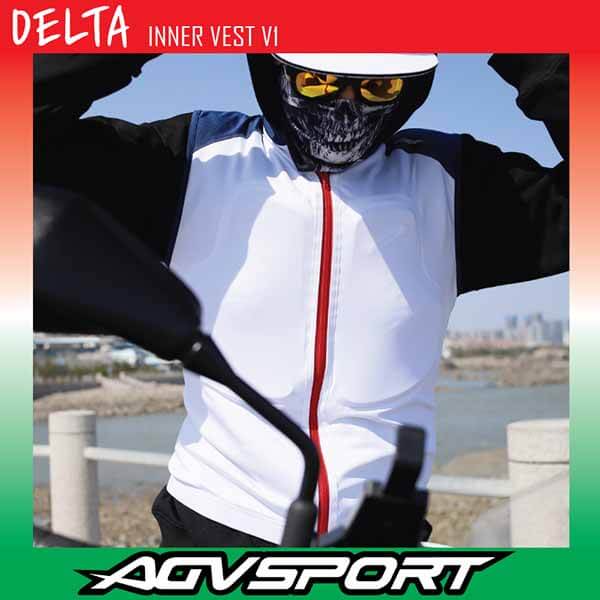
Some of the deadliest injuries during a motorcycle crash are in the chest. Wearing an armored vest can help reduce injury and even save your life in the event of an accident. The vests fit over your torso perfectly and offer excellent protection to your chest, front, and back.
Armored vests feature a rugged, abrasion-resistant thermoplastic shell on the exterior and a soft, padded interior to cushion your body from impact.
Besides, some of these vests are designed with a polyethylene (PE) plastic shell to provide you with high impact and penetration resistance. They’re also integrated with a viscoelastic foam to provide users with adhesive synthesis.
2. Armored Suits
Armored suits come in two main options. You can opt for a one-piece suit or a two-piece alternative that connects around the waist. Both suits feature strategic armor placements in the back, shoulders, elbows, hips, legs, and knees.
What is more, many armored suits have an ergonomic design of hard armor outside plates with shock-absorbing soft, resilient foam lining. They secure your back, neck, and wrist to the greatest extent possible, mainly due to their high-quality materials, such as memory foam.
Some come with multiple wide vents of plastic shells and foam for full ventilation, moveable liners for quick cleaning, high material for the folding rear restraint, and waist armor. The pads on the sides of the waist shield can be thickened to help cover the entire body.
If you ride a motorcycle, you should invest in good protective armor to ensure that you are protected when riding.
3. Armored Shirts

The benefit of wearing an armored shirt is that the elasticated fabric of the garment allows the contoured armor to remain optimally attached and positioned during riding and in case of a crash.
For the convenience of maintenance and storage, all cushions in armored shirts are removable. But you need to be cautious enough to avoid cheap motorcycle jackets, which have terrible fit and armor locations, leading to dangling armor that rotates quickly in a motorcycle crash. This leaves the rider unprotected against impacts.
In a nutshell, armored shirts allow you to wear your favorite motorcycle jacket over your armored undershirt (with the jacket’s stock armor removed) to boost your overall protection against impacts if you fall.
Because armored undershirts lack an abrasion-resistant lining, they can be worn for any form of high-speed riding, such as track racing, as long as a high-quality motorcycle jacket is worn over them.
4. Armored Pants
Depending on where and under what conditions you ride and the type of motorcycling, armored pants will be made of either leather or textiles, and they both protect the legs, hips, pelvis, and knees.
With adjustable elastic fast-release bands for a perfect fit and quick removal, knee armor in the armored pants closely matches the movement of the knee to provide the most natural and flexible experience possible.
However, it is recommended that you look for features that best fit your riding style and then see what you can afford based on your budget. Road use is quite different from off-road use. Street riders will prefer leather, road racers must-have leather, while Motocross MX riders will always have textile garments.
5. Armored Shorts
What happens when the last thing you want to wear is a heavy armored vest or armored suit, but you still want to ride your motorcycle safely? Well, there is another option available: armored shorts.
Most armored shorts have padding in strategic areas, particularly the hips, to provide a higher level of protection, increasing the likelihood of a motorcyclist surviving an accident.
In terms of ventilation, they come with multiple large vents in plastic shells and foam for maximum comfort and ventilation, eliminating moisture and heat to keep you cool and cozy without delay during the sport.
Michael’s Summary and Conclusion
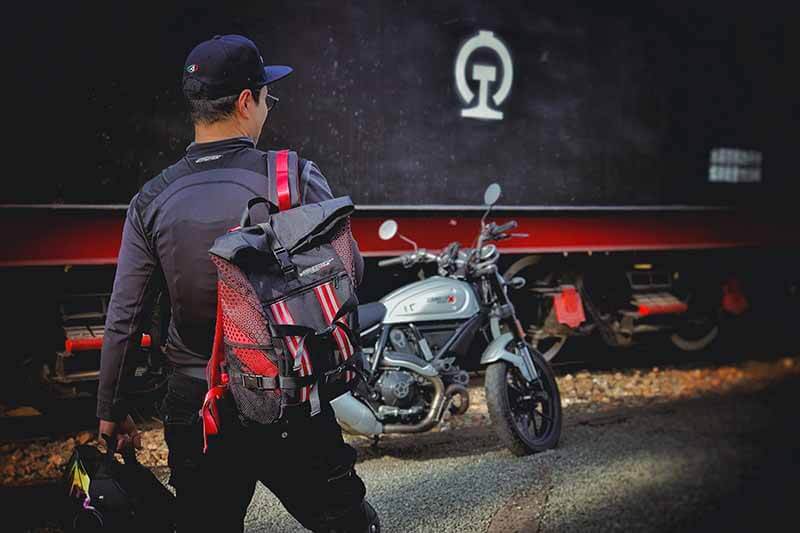
Yes! Motorcycle body armor is worth the investment. We are all mindful of the inherent dangers of motorcycle riding and that the safest risk-reduction technique is to ride defensively and with the best gear and most protective gear available. Wearing motorcycle armor can enhance all these, significantly reducing the risk of injury in the event of a crash.
Most motorcycle riders know they should wear a helmet or at least know the law requires them to wear one. However, they still go for a ride without wearing gloves, motorcycle boots, or even a good jacket. There are many reasons for this, but mostly it comes down to convenience and just being lazy and being overconfident about the likelihood of an accident. But all the reasons for not wearing gloves, boots, or jackets are only amplified when it comes to a rider deciding whether to wear motorcycle body armor.
The worst injury I ever had was when I was riding in Thailand with a pair of sneakers instead of anything that could’ve been considered an excellent choice for motorcycling. I spent six months regretting that decision. Although in the ideal perfect world, motorcycle body armor should always be worn. But we all know that just isn’t going to happen.
A good compromise would be for riders to think about the type of riding they are going to be doing, the environment, the speed, and how aggressive they’re going to be and then consider using the safety gear on at least some of their motorcycle rides. For any type of racing, whether it be road or off-road, motorcycle body armor should not be considered an option. For street riding, at least have a good back protector/spinal pad in your jacket.
So, the big question is, what are you waiting for? All you need to do is choose the best based on your needs.

I've diligently categorized my motorcycle gear recommendations into all available categories, with the aim of providing you with a comprehensive analysis that showcases the absolute best options for all your needs. These items are the culmination of in-depth research, extensive testing, and personal use throughout my vast experience of 50+ years in the world of motorcycling. Besides being a passionate rider, I've held leadership positions and offered consultancy services to reputable companies in over 25 countries. To See Top Picks and the Best Prices & Places to Buy: Click Here! |
Information for this article was partially sourced and researched from the following authoritative Government, educational, corporate, and nonprofit organizations:
- The George Institute of Good Health
- European Commission
- Kelly & Associates Injury Lawyers
- Techno FAQ
- Motorcycle Accident Resource
- Motorcycle Legal Foundation
M/A


